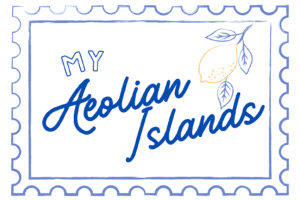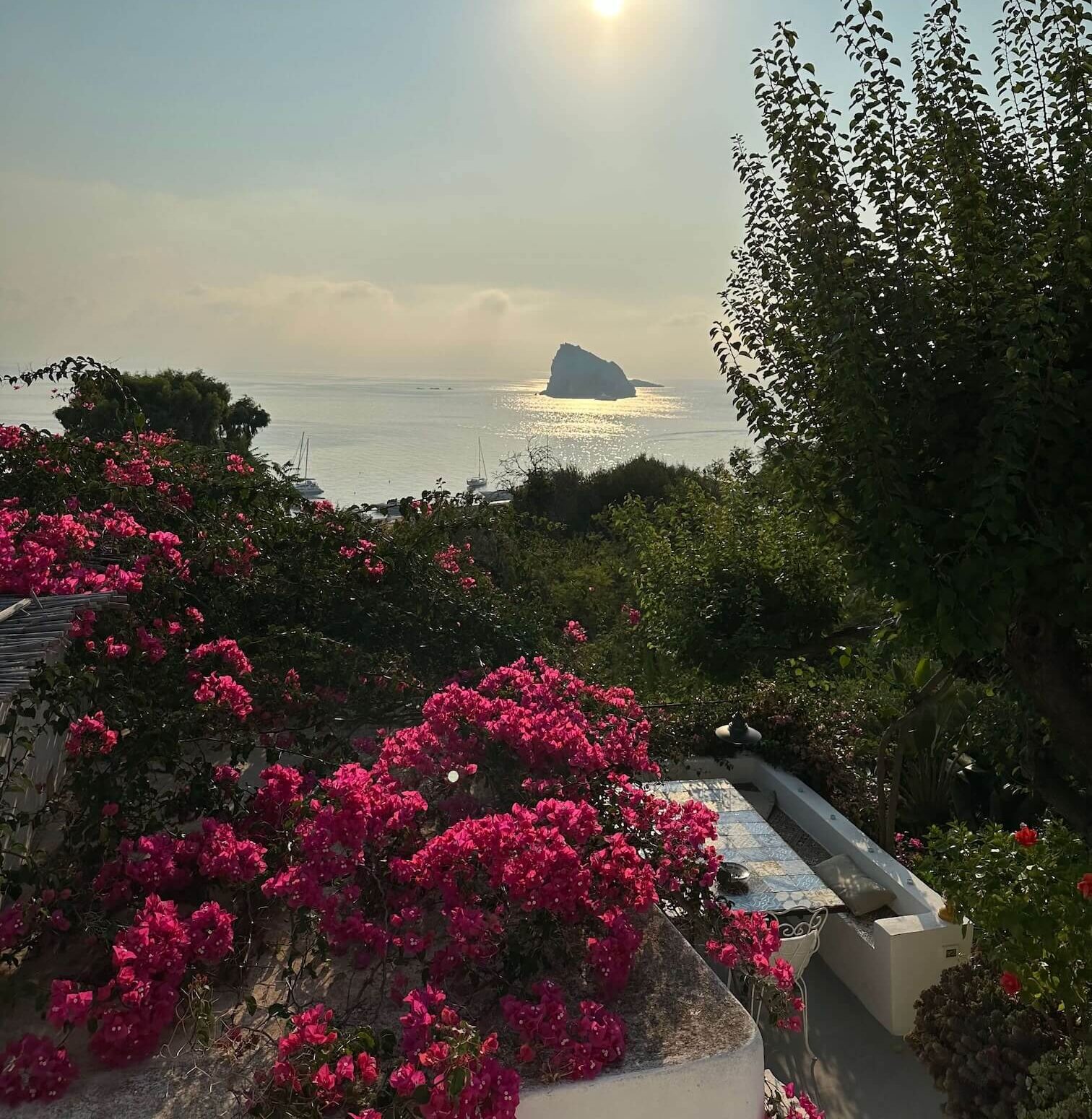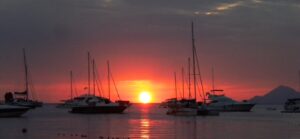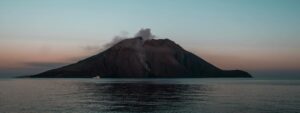Tiny, sunlit, and impossibly beautiful, Panarea feels like a postcard come to life. Walk its narrow lanes, swim in blue coves, and watch Stromboli glow in the distance. This is island life at its peak.
In this article
Panarea: The perfect postcard Aeolian Island
There’s a moment, just before the hydrofoil slows and the little white houses of Panarea appear in the distance across the bouganvillae, when the sea seems to shimmer differently. The air feels softer, scented with salt and jasmine, and the sun reflects off the cliffs like a postcard come to life. That’s the magic of Panarea, the smallest of the Aeolian Islands, but perhaps the one with the biggest presence.
From afar, it looks like a watercolour painting: a scattering of white cubes among lush green slopes, framed by turquoise water and the dark silhouette of Stromboli in the background. Up close, it’s a world of narrow alleys lined with flowers, hand-painted ceramic signs, and cobalt-blue doors.
It is true, Panarea has a reputation: chic, exclusive, effortlessly expensive, but beyond the linen dresses and wooden yachts, there’s something more timeless here. It’s the rhythm of the island itself: mornings spent swimming in clear coves, lazy afternoons under fig trees, and golden evenings when the sea glows pink and everything seems to pause.
I’ve been visiting the Aeolian Islands for years, and still, every time the boat turns toward Panarea, I feel the same quiet thrill. It’s that rare kind of place that manages to be both glamorous and deeply peaceful, where beauty feels so natural it is effortless. It’s a sight that never loses its magic, no matter how many times you’ve seen it.
How to reach Panarea
Most travellers arrive via Milazzo, the main gateway to the Aeolian Islands on Sicily’s north coast. From there, hydrofoils operated by Liberty Lines leave several times a day, stopping at Lipari and Salina before reaching Panarea (read more about reaching the Aeolian Islands here). The journey takes about two hours, sometimes a little more if the sea feels lazy.
In summer, connections between islands are frequent, so you can easily hop from Panarea to Stromboli or Lipari for a day trip.
All boats arrive at San Pietro, Panarea’s tiny harbour. The port is little more than a curve of stone with a few fishing boats and a café. From here, everything is within reach, the village, the paths, the beaches, the views. You won’t see cars or buses waiting at the dock, only small electric carts and a few smiling locals offering rides to hotels.


Getting around the Island
One of the best things about Panarea is what you won’t find here: no cars and no traffic. The island moves at walking pace, and that’s exactly how it should be.
Most people get around on foot, from the port of San Pietro, it’s an easy walk to anywhere you’ll want to go. If walking isn’t your thing, don’t worry. Locals use electric carts and three-wheeled Ape taxis that move quietly through the narrow lanes. They’re not just practical, they’re part of the island’s charm. You’ll often see them loaded with baskets of fruit, or the occasional dog sitting proudly in the front seat.
Distances here are short, but time stretches. It might take you ten minutes to reach your hotel, or an hour, depending on the slope and how many times you stop to take photos 😉
If you decide to explore further, toward Drautto or Capo Milazzese, wear good shoes. The volcanic rock can be uneven, and the paths can get hot under the Sicilian sun. But every walk here rewards you twice: once with a view, and again with the feeling that you’re exactly where you’re meant to be.
What to see and do
San Pietro village
San Pietro is where everything begins and ends: the port, the piazza, the cafés, the church that watches over the sea.
The village is small. Imagine white cube-shaped houses framed by blue doors, terraces shaded by olive trees, and ceramic pots overflowing with geraniums and sleepy cats at their feet. Every corner looks like a film set that never needs direction.
Start your day with coffee at one of the bars by the port, Da Carola is a classic, and watch as the island slowly wakes up. Fishermen mend their nets, the smell of freshly baked brioche drifts from a nearby bakery, and the sound of waves fills the pauses in conversations.
In the afternoon, wander the narrow paths uphill, where boutiques sell handmade jewelry, linen dresses, and the kind of sandals you’ll end up wearing all summer. If you get lost, that’s perfect, every detour on Panarea leads somewhere beautiful.
As sunset nears, the sky turns apricot and lavender, the horizon glows behind Stromboli, and the village gets ready for dinner and music. Panarea’s evenings are long, fancy, and full of light.
Cala Junco & Capo Milazzese
If Panarea has a postcard image, it’s Cala Junco, a horseshoe-shaped bay enclosed by volcanic cliffs, where the water glows every shade of blue and green imaginable.
It’s a 25 minute walk from San Pietro, following a path that climbs gently past trees and stone terraces before descending toward the sea. You’ll hear the sound of waves long before you see them. Then, suddenly, the view opens to a perfect natural amphitheater. In my opinion, it’s one of the best swimming spots in the Aeolian Islands, especially early in the morning.
Above the bay stands Capo Milazzese, a Bronze Age settlement dating back nearly 3,500 years. The ruins are simple, just low walls of volcanic stone, but their position is extraordinary. Bring water, a hat, and extra time. The hike down is easy enough, but once you reach Cala Junco, you won’t want to leave. Some travelers pack a small picnic, others just float in the clear shallows until the shadows grow long. If you’re lucky, you might have the whole bay to yourself, just you, the sea, and the slow rhythm of island life.
The islets around Panarea
Panarea isn’t alone. Just offshore lie a constellation of tiny volcanic islets, Basiluzzo, Dattilo, Lisca Bianca, Lisca Nera, Bottaro, and a few more nameless rocks that rise from the sea like sleeping whales. Together, they form a miniature archipelago.
The best way to see them is by boat. You can rent a small gozzo with a local captain, or join one of the daily excursions that circle the island. The experience feels almost mythic, sailing past cliffs of black rock streaked with orange minerals, stopping to swim in coves only accessible from the sea.
Just east of Panarea lies Basiluzzo, the largest of the islets, a pyramid of green rising straight from the blue. Lisca Bianca is famous for its underwater fumaroles, bubbles rising gently from volcanic vents beneath the sea. You can swim right through them, and believe me, this is a true experience of the wonders of nature.
Locals will tell you to go early in the morning or just before sunset, when the light turns everything gold and the water looks like liquid glass. If you’re lucky, you might spot dolphins following your boat, or Stromboli glowing faintly in the distance.
Hiking & walks
Though Panarea is known for its glamour, it’s also a paradise for wanderers. The island is small, but its volcanic terrain offers paths that wind through cactus fields, olive groves, and wild thyme-covered slopes.
One of the most rewarding hikes leads to Punta del Corvo, the island’s highest point at 421 meters. The path begins just outside San Pietro and climbs gently before cutting across open hills that overlook the sea. The trail is about an hour each way, depending on how often you stop (and you’ll want to stop often).
There are shorter walks too: the gentle path from San Pietro to Drautto, lined with cactus and stone villas, or the route to Cala degli Zimmari, a small red-sand beach just before Cala Junco.
Sunset & aperitivo
Panarea is an island that knows how to do evenings well. As the sun begins to lower, the air cools, and life slowly shifts toward the terraces. The most famous spot is Hotel Raya, perched high above the village with a view that stretches all the way to Stromboli. Some come to dance, others just to sit with a drink and watch the volcano blink in the night. Either way, it’s pure Panarea.
If you prefer something quieter, find one of the smaller terraces overlooking San Pietro, Da Pina or Cusiritati both have a wonderful, intimate charm. The ritual is the same everywhere: good company, sea breeze, and that soft feeling that the day has ended in the best way.
In summer, there are sometimes small concerts, local festivals, and open-air dinners organized by residents, simple things with grilled fish, homemade wine, and loud laughter. If you’re lucky enough to stumble upon one, stay. Panarea’s true beauty isn’t found in guidebooks or Instagram photos, but in those moments when you’re invited into the island’s true pace.
You look around and realize: this is what people mean when they say la dolce vita.
Where to stay
Most accommodations are clustered around San Pietro, where the port, restaurants, and small shops are all within easy walking distance. If you want something iconic (but definitely expensive), there’s Hotel Raya, perched high on the hill with one of the most spectacular views in all of the islands. From its infinity pool, you can watch Stromboli puffing in the distance.
For something quieter and more personal, smaller hotels like La Piazza or Lisca Bianca offer lovely rooms right above the sea. There are also family-run guesthouses and villas tucked into the hills, where owners welcome you like old friends, often with a glass of Malvasia and a story about how Panarea used to be “before the ferries.”
If you visit in May, June, or September, the island feels especially intimate, warm days, calm evenings, and just the right amount of life. In high summer, Panarea gets busy, with music on the terraces and boats anchored offshore, but even then, the magic remains.
The essence of Panarea
Panarea isn’t just beautiful, it feels beautiful. It’s just the way everything seems perfectly in tune. There’s an elegance here that isn’t about luxury, but about simplicity done well. A linen tablecloth fluttering in the breeze. A fishing boat painted turquoise. The golden light that softens everything at dusk.
Compared to its sisters, Panarea feels both intimate and refined. The island’s beauty has always drawn a certain kind of visitor: artists, travelers, dreamers, and yes, the occasional celebrity. But what keeps people coming back isn’t glamour, it’s the atmosphere.
Despite its fame, Panarea has managed to keep its soul. The fishermen still mend their nets by the port, the island children still dive from the rocks, and locals still gather in the piazza at night, greeting each other as if time itself hasn’t moved.
Day trips & connections
From Panarea, you can reach almost any Aeolian island within a relatively short time.
Stromboli is the obvious choice, a living volcano that glows at night. Boats leave in the afternoon, circle the island, and pause offshore to watch lava trails tumble into the sea. It’s one of nature’s most unforgettable performances.
Lipari, the largest island, offers a bit more bustle. Spend a morning wandering its old town or visiting the Archaeological Museum before heading back to Panarea for sunset.
Salina, green and fragrant, is famous for its capers and Malvasia wine. You can spend the day tasting both.
Many visitors join a private boat tour that combines several islands in one lazy day. Swim in hidden coves, eat pomodori on deck, and watch the sun fall behind Filicudi on the return.
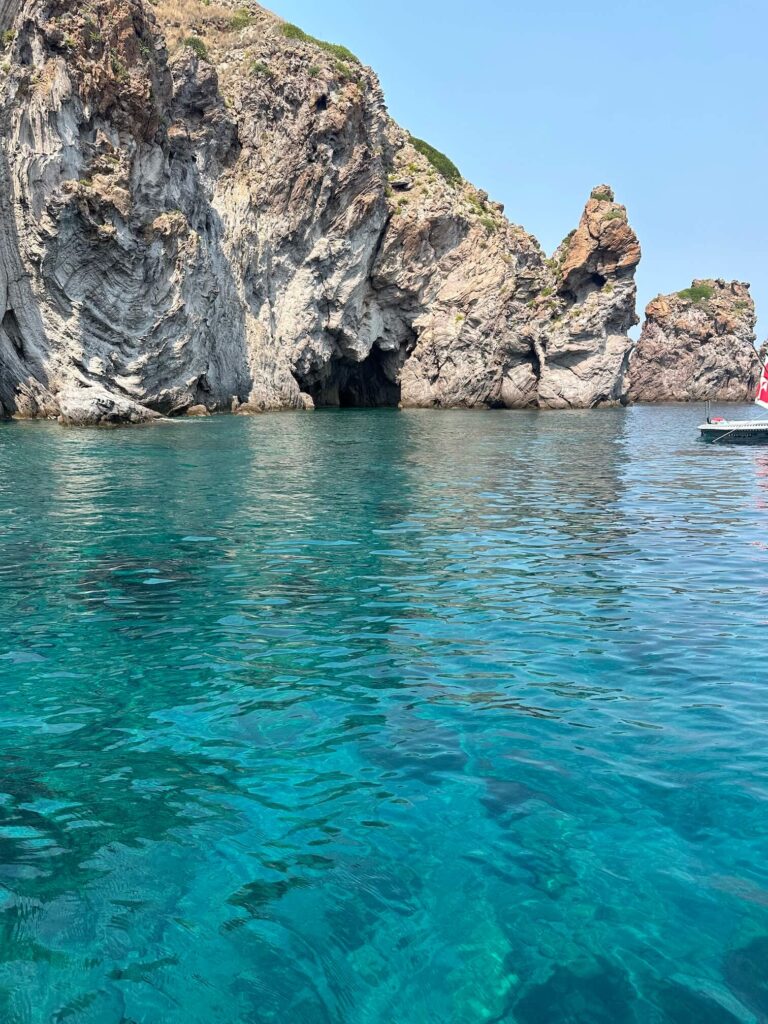
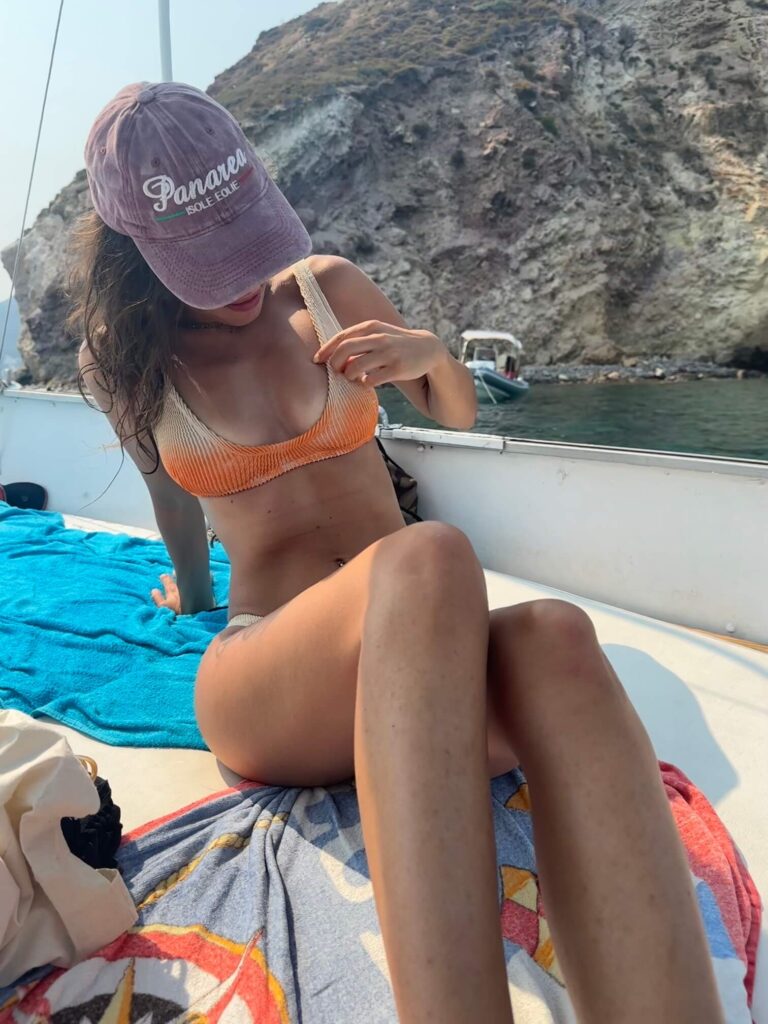
FAQ about Panarea
Is Panarea worth visiting?
Absolutely. Though small, Panarea is one of the most beautiful islands in the Mediterranean. It combines natural beauty, history, and an effortless elegance you won’t find anywhere else.
How many days do you need in Panarea?
Two or three days is perfect, enough to explore the village, swim at Cala Junco, and take a boat around the nearby islets. That said, many travelers plan to stay a weekend and end up staying a week. Panarea has a way of slowing time.
Are there cars on Panarea?
No cars, and that’s part of its charm. You’ll get around on foot, by electric cart, or with small three-wheeled Ape taxis. The island is tiny, and walking is the best way to experience its beauty.
When is the best time to visit Panarea?
May, June, September, and early October are ideal, warm, calm, and not too crowded. July and August are lively and glamorous, with longer nights and more visitors.
Can you visit other Aeolian Islands from Panarea?
Yes, boats connect Panarea to Stromboli, Lipari, and Salina daily. You can also join private excursions to swim around Basiluzzo and the smaller islets nearby.
Is Panarea expensive?
Compared to other Aeolian Islands, yes, especially in peak summer. Accommodation and dining can be pricier due to limited space and high demand. But it’s also easy to enjoy Panarea without spending too much: stay in a small guesthouse, eat at local trattorias, and spend your days walking and swimming, both free and worth it.
Can you visit Panarea as a day trip?
You can, there are organized boat trips from Lipari or Stromboli, but you’ll only get a glimpse. If you can, stay at least one night to feel the island’s rhythm once the day-trippers leave.
Panarea: picture perfect postcard
Panarea isn’t a place you visit once and forget. Maybe it’s the scent of flowers carried on the evening wind, or the memory of diving into water so clear it felt unreal. Or maybe it’s that unmistakable feeling that for a few days, you lived inside a painting.
For me, every time I come back, it feels familiar but never the same. The island changes subtly with the light, the wind, the people passing through. When people ask me which Aeolian Island they should visit first, I usually hesitate. They’re all different, all beautiful. But if you want to understand what makes this archipelago so naturally poetic, start with Panarea.
